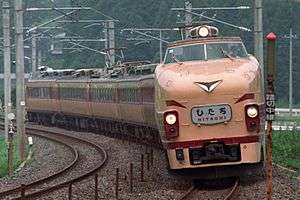201 series
| 201 Series | |
|---|---|
|
Chūō Line 201 Series stock, May 2006 | |
| In service | 1979 - Present |
| Manufacturer | Hitachi, Kawasaki Heavy Industries, Kinki Sharyo, Nippon Sharyo, Tokyu Car Corporation |
| Refurbishment | 2003–2007 (JR-West) |
| Number built | 1,018 vehicles |
| Number in service | 224 vehicles |
| Number scrapped | 793 vehicles |
| Operator(s) |
JNR (1979-1987) JR East (1987-2011) JR-West (1987-Present) |
| Depot(s) |
Morinomiya Nara |
| Line(s) served | Osaka Loop Line, Yamatoji Line, Sakurai Line, Wakayama Line, Osaka Higashi Line |
| Specifications | |
| Car body construction | Steel |
| Car length | 20 m |
| Maximum speed | 100 km/h (60 mph) |
| Traction system | Thyristor chopper |
| Acceleration | 2.5 km/h/s |
| Deceleration | 3.5 km/h/s |
| Electric system(s) | 1,500 V DC overhead |
| Current collection method | PS21 diamond-shaped pantograph |
| Braking system(s) | Regenerative brake, electro-pneumatic brake |
| Safety system(s) | ATS-S, ATS-SN, ATS-SW, ATS-B, ATS-P |
| Track gauge | 1,067 mm (3 ft 6 in) |
The 201 series (201系 Nihyaku-ichi-kei) is a commuter electric multiple unit (EMU) train type introduced in 1979 by Japanese National Railways (JNR), and currently operated by West Japan Railway Company (JR-West), and formerly also operated by East Japan Railway Company (JR East).
It was the first JNR train to use electronic chopper control.[1]
Operations
The 201 series stock has been used on a large number of lines.
JR-West
- Tokaido Main Line, Sanyo Main Line (Biwako Line, JR Kyoto Line, JR Kobe Line) (Kusatsu - Kakogawa) (from 1983 to 2007)
- Kosei Line (from 1997 to 2007)
- Fukuchiyama Line (JR Takarazuka Line) (from 1997 to 2007)
- Osaka Loop Line (from 2005 to present)
- Sakurajima Line (JR Yumesaki Line) (from 2005 to present)
- Kansai Main Line (Yamatoji Line), Sakurai Line (Manyo Mahoroba Line), Wakayama Line (from 2006 to present)
- Osaka Higashi Line (from 2008 to present)
-

201 series on JR Kyoto Line service, August 2004
-

Osaka Loop Line 201 series refurbished train, May 2007
-

Yamatoji Line 201 series refurbished train, December 2007
JR East
- Chūō Rapid Line (from 1979 to October 2010)[2]
- Chūō-Sōbu Line (from 1982 to 2001)
- Ōme Line (from 1999 to 2008)
- Itsukaichi Line (from 1999 to 2008)
- Hachikō Line (Hachiōji - Komagawa, until March 2008)
- Keiyō Line, Sotobō Line, Tōgane Line (from 2000 to 20 June 2011)[3]
-

A Chuo/Ōme Line 201 series in October 2010
-

A Keiyo Line 201 series in February 2007
-

A Chūō-Sōbu Line 201 series in May 2001
Shikisai train
A 4-car 201 series set (W1) was modified in 2001 by JR East to become the special Shikisai (四季彩) tourist train, entering service on the Ōme Line from 4 August 2001. This train featured panorama windows and transverse seating bays on one side of the train only. It was repainted into a new livery in June 2005.[4] The train was withdrawn from regular service at the end of June 2009, with a number of special finale runs scheduled for July.[5]
-

Shikisai train in original livery, May 2004
-
Shikisai train in revised livery, June 2007
-
.jpg)
Interior view, November 2008
References
- JR全車両ハンドブック2006 [JR Rolling Stock Handbook 2006]. Japan: Neko Publishing. 2006.
- ↑ "201系四半世紀の歩み". Japan Railfan Magazine. 45 (526). February 2005.
- ↑ JR East news release: "「さよなら中央線201系」キャンペーン<第2弾>を開催します" (25 February 2010). Retrieved 17 June 2010. (Japanese)
- ↑ 京葉線の201系が定期運用を終える [Keiyō Line 201 series withdrawn from regular service]. Japan Railfan Magazine Online (in Japanese). Japan: Koyusha Co., Ltd. 21 June 2011. Retrieved 21 June 2011.
- ↑ JR電車編成表 2009夏 [JR EMU Formations - Summer 2009]. Japan: JRR. June 2009. ISBN 978-4-330-06909-8.
- ↑ Japan Railfan Magazine: "201系「四季彩」,青梅線定期運用を終了" (28 June 2009). Retrieved on 28 June 2009. (Japanese)
External links
| Wikimedia Commons has media related to 201 series. |
- "JR East 201 series". Archived from the original on 15 January 2008. Retrieved 2008-01-21. (Japanese)

